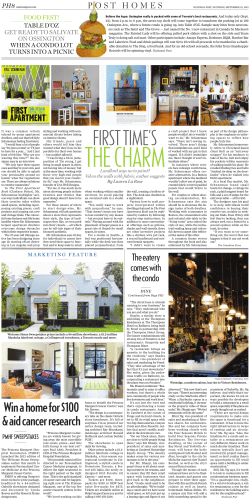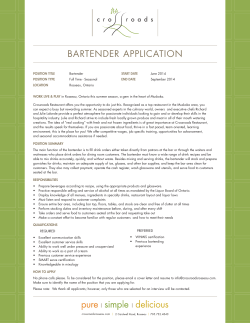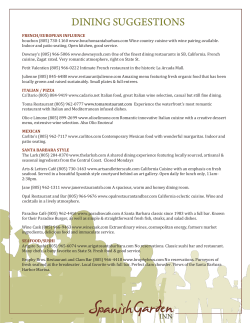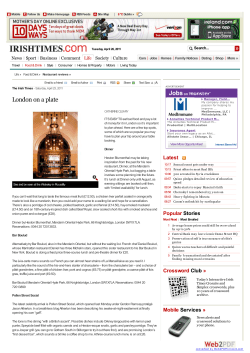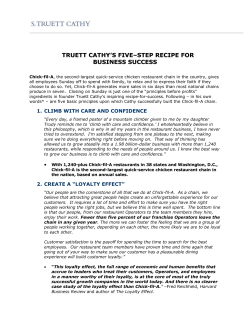
C M RESTAURANT
CITY OF MILPITAS RESTAURANT DESIGN GUIDE Building & Safety Department 455 E. Calaveras Blvd. Milpitas, CA 95035 408-586-3240 www.ci.milpitas.ca.gov 1. PERMIT INFORMATION: A restaurant is any building, other than a dwelling unit, where food is processed, stored, prepared, served, sold, or consumed at the facility. Restaurants must meet a number of special standards. A building permit is needed whenever a restaurant is built, remodeled, altered, or expanded. For further information please contact the Building & Safety Department at 455 E. Calaveras Blvd, call (408) 586-3240 or contact our website at: http://www.ci.milpitas.ca.gov /government/building Permits may be issued only to a State of California Licensed Contractor or the Building Owner. If the work is performed by the Building Owner personally or by his/her workers and an inspection indicates the work cannot be completed satisfactorily, then a licensed contractor must perform the work. If the Building Owner hires workers, State Law requires the Owner to obtain Worker’s Compensation Insurance. Proof of this insurance is required prior to inspection. 2. PLAN REQUIREMENTS & APPROVALS: All tenant improvement projects require drawings. Typically, these drawings must be signed by a California Registered Engineer or Architect. Refer to the handout “Plans Required to be Designed by an Architect or Engineer” for additional information. Five (5) sets of construction drawings describing the proposed work for any restaurant must be submitted for review and approval prior to obtaining a building permit. If any rooftop-mounted equipment is to be installed, a roof plan and elevation must be included to demonstrate that the equipment cannot be seen from adjacent streets. The construction drawings must be complete including plans showing all electrical, plumbing, and mechanical work. Refer to the handout “Commercial Plan Requirements Restaurant Tenant Improvement A-2 Occupancy” for occupancies of 50 or more or the handout “Commercial Plan Requirements Office Tenant Improvement B Occupancy”: for occupancies of 49 or fewer. City Planning Department review and approval is needed for all restaurant projects. For further information please contact the Planning Department at 455 E. Calaveras Blvd or call (408) 586-3279. The Santa Clara County Department of Environmental Health must review and approve the plans for all restaurants, commercial kitchens, food preparation facilities, and any other food service facility in which food is processed, handled, sold, or distributed. Health Department approval must be obtained prior to the City completing the plan review for the building permit. The Santa Clara County Health Department is located at 1555 Berger Drive, Suite 300 in San Jose, CA or call (408) 918-3400. Once the plans have been approved by the Health Department, submit both signed sets to the City Building & Safety Department. The sewer system in Milpitas is operated by the Santa Clara Water Pollution Control Plant (SCWPCP). SCWPCP must review and approve the plans for all new or expanded restaurants. Take the approved Health Department drawings to the SCWPCP before submitting to the City. SCWPCP is located at Old Martin Luther King Library at 170 W. San Carlos Street in San Jose, CA or call (408) 945-3000. It is recommended that anyone planning on building or expanding a restaurant to contact Allied Waste for information on garbage pickup. Allied Waste is located at 1601 W. Dixon Landing Road or call (408) 432-1234. Refer to the handout “Development Guidelines for Solid Waste Services” for additional information. CH Restaurant Design Guide Page 1 of 7 06/06/14 Milpitas Building & Safety Department Restaurant Tenant Improvement 3. CODE REQUIREMENTS CODE: All work must comply with the 2013 Building Code Standards (Building, Electrical, Mechanical, Plumbing, Energy and Green Building Standards) and the 2014 Milpitas Municipal Code. RESTROOMS: Restaurants serving food on the premises must have restroom facilities available to customers. Specialty restaurants with small seating areas of 300 square feet or less may have a single restroom, which can be utilized by both customers and employees. Restaurants with seating areas larger than 300 square feet need separate restrooms for men and women. For the number of water closets and lavatories in each restroom, refer to Table “A”. When all of a restroom’s doors (including entrance and partition doors) are in the open position, toilets and urinals cannot be visible, either by direct line-of-sight or by reflections from mirrors, from outside the restroom. Table “A” Minimum Quantity of Plumbing Fixtures in Restaurants Dining Area (In Square Feet) Up to 300 Men Toilets Urinal Women Lavatory Toilets Lavatory A single Restroom with one toilet and one lavatory is acceptable 301 to 1,470 1 - 1 1 1 1,471 to 3,000 1 1 1 2 1 3,001 to 6,000 2 1 1 3 1 6,001 to 9,000 2 1 1 4 1 9,001 to 12,000 3 1 2 4 2 12,001 to 18,000 3 2 3 6 3 18,001 to 24,000 4 3 3 8 3 Separate facilities shall be provided for employees when dining area exceeds 3,000 square feet. Dining area is the net area in which tables are set up for eating. Lobbies, entries, and reception areas need not be counted. ACCESSIBILITY: All restaurants must be accessible to persons with disabilities. This includes both employees and patrons. Some, but not all, of the accessible features that restaurants must have are: • • • • • A minimum of 36 inches long portion of the cashier counter must be no higher than 28 to 34 inches above the floor. In restaurants and bars where dining surfaces are provided for consumption of food or drink, at least 5% of seating and standing spaces at dining surfaces shall have clear floor space of 30”X48” with 19” deep minimum at 27”height knee clearances. Accessible dining surfaces shall be dispersed through entire facility and no less than one shall be located in each functional area (dining, banquet, bar, raised or sunken area, outdoor seating). When more than one accessible space is provided, they shall be integrated throughout the general seating area(s). For bar counter exceeding 34” in height that is accessible by the customers at least 60” long portion of the counter shall be accessible. Tray slides at food counters shall be 28” minimum and 34 inches maximum above the floor (refer to Figure “B”). Self-service dispensing devices for tableware, dishware, condiments, and beverages shall comply with Figure “B”. All restrooms shall be accessible to persons with disabilities. CH Restaurant Design Guide Page 2 of 7 06/06/14 CH Restaurant Design Guide Page 3 of 7 06/06/14 Milpitas Building & Safety Department Restaurant Tenant Improvement Figure “B” Access to Dispensing Units TABLE SPACING IN RESTAURANTS: Aisles and circulation ways in dining rooms utilizing movable tables and chairs must be maintained to provide safe exiting at all times. Dining, banquet and bar facilities shall be made accessible to persons with disabilities. Each area shall have at least 5% of seating spaces, but not less than one, wheelchair accessible seating space. Access to such seating spaces shall be not less than 36” clear width. For details showing minimum dimensions, please refer to Figure “C.” through “G “. Figure “C” Typical Aisles for Restaurant Seating CH Restaurant Design Guide Page 4 of 7 06/06/14 Milpitas Building & Safety Department Restaurant Tenant Improvement Figure “D” Seating and Tables Figure “E” Figure “F” Counters Required knee space GREASE TRAPS AND INTERCEPTORS: The Plumbing Code requires that the waste from specified plumbing fixtures in a commercial kitchen be discharged through a grease trap or interceptor. Grease trap and interceptor sizing and design approval is under the jurisdiction of the San Jose/Santa Clara Water Pollution Control Plant. Utensil sinks, pot sinks, and floor drains must be connected to either a grease trap or interceptor. Dishwashers are prohibited from discharging into a grease interceptor if one is available. Garbage disposals are prohibited from discharging into either a grease trap or interceptor. INDIRECT WASTE: Because of the potential for contamination, certain plumbing fixtures and food handling equipment cannot be connected directly to the sewer system. The fixtures and equipment listed below must drain into a receptor, which can accommodate an air gap. Generally, a floor sink is used as a receptor (see Figure “G”). CH Restaurant Design Guide Page 5 of 7 06/06/14 Milpitas Building & Safety Department Restaurant Tenant Improvement Figure “G” Typical Indirect Waste Food prep sinks, steam tables, icemakers, condensate drains, soda dispensers and coffee makers. TRAP SEAL PROTECTION: Provide trap seal primers at floor drains and floor sinks. CARBONATORS: Potable water supply to carbonators shall be protected by either an airgap or a vented backflow preventer for carbonated beverage dispensers installed within the carbonated beverage dispenser. EQUIPMENT: Equipment must be installed in accordance with the manufacturer's requirements. EXHAUST HOODS: Any piece of equipment used in a food establishment which produces grease vapors, steam, fumes, smoke, or odors shall be equipped with either a Type I or Type II exhaust hood. Type I hoods are used over cook tops, grills, deep fat fryers, and similar grease producing equipment. Hoods must be equipped with an automatic fire suppression system. A separate permit (in addition to any building permits) shall be obtained from the Milpitas Fire Department for the installation of all Type I hoods. Type II exhaust hoods are used over appliances, which generate grease free steam, hot air, smoke, or odors. The installation of Type II exhaust hoods needs a building permit but does not need a separate permit from the Fire Department. Refer to specific equipment listing to verify if Type I or Type II exhaust hood is required. SUPPORT AND LATERAL BRACING FOR KITCHEN HOOD: Replacement of existing or new installation of kitchen hood requires calculations and details of the supports and lateral bracing when the hood is more than 20 pounds. Details shall include location of supports and bracing and their sizes, connections of support & bracing at the top of the hood and the bottom of the existing structure. Supports of hood shall not be connected to the existing 2X rafter (see Figure “H”). Figure “H” Sample of Support & Lateral Bracing for Hood CH Restaurant Design Guide Page 6 of 7 06/06/14 Milpitas Building & Safety Department Restaurant Tenant Improvement Automatic Gas Shut-off Devices: Automatic Gas Shut-off Devices shall be installed at each new gas fuel appliance outlet per Milpitas Municipal code Title II, Chapter 170 (see Figure “I”). Figure “I” Quick disconnect flexible gas line installation detail ROOF TOP VENTILATORS: Rooftop kitchen ventilators must be listed for its use ELECTRIC MOTOR DISCONNECTS: All electric motor operated equipment must have a disconnect switch within 50 feet and be in sight of the equipment and be motor rated COOKING APPLIANCES: Cooking appliances labeled “for household use only” may not be installed WARMING OVENS: Warming ovens installed in combustible countertops must be rated for such location ELECTRICAL EQUIPMENT RATING: All electric circuits and equipment operating for more then 3 hours to be rated for continues use KITCHEN EXHAUST VENTILATORS: Kitchen exhaust ventilators are to be interlocked with the makeup air fans RECEPTACLES: All general use electric receptacles to be of GFCI type ELECTRICAL WIRING: Electric wiring in the high temperature hood must be rated for high temperature Note: Most Compact Fluorescent Light bulbs are not rated for that use and may be a fire hazard 4. INSPECTION PROCEDURES The number of inspections that will be required will depend on the scope of the work to be performed. Meet with the Building Inspector on the site early to find out when your project will have to be inspected. A final inspection shall be scheduled after all work is complete. For each inspection, the Permit Card and the Approved Job Copy of the Drawings must be presented to the inspector. Permits expire 180 days after issuance or last inspection passed, whichever is the latest. 5. QUESTIONS: If you have any questions regarding your project, contact the Building & Safety Department at (408) 586-3240. CH Restaurant Design Guide Page 7 of 7 06/06/14
© Copyright 2026





![[NAME OF COMPANY] BUSINESS PLAN EXECUTIVE SUMMARY](http://cdn1.abcdocz.com/store/data/000170276_1-284f4fa6e5a0875864aa4c4eda5619d7-250x500.png)
